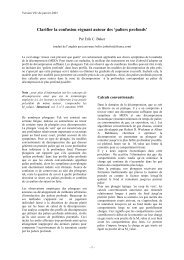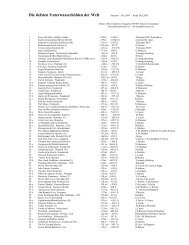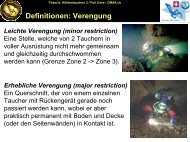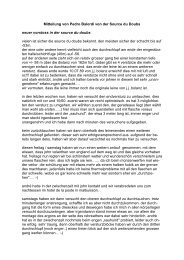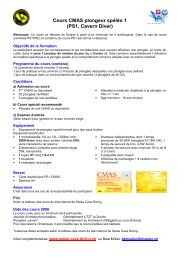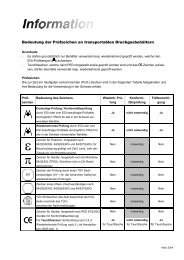cave diving and the nss - bei Swiss-Cave-Diving
cave diving and the nss - bei Swiss-Cave-Diving
cave diving and the nss - bei Swiss-Cave-Diving
Create successful ePaper yourself
Turn your PDF publications into a flip-book with our unique Google optimized e-Paper software.
36 CAVE DIVING COMMUNICATIONS<br />
<strong>the</strong> "Back up" movements are repeated <strong>and</strong> intense, <strong>the</strong> rear diver<br />
may be signaling for assistance.<br />
If <strong>the</strong> rear diver pushes on <strong>the</strong> lead diver, but <strong>the</strong> lead diver<br />
doesn't move, it means ei<strong>the</strong>r that <strong>the</strong> lead diver has a problem,<br />
<strong>the</strong> passage has pinched down so as not to be passable, or <strong>the</strong><br />
lead diver could not feel <strong>the</strong> o<strong>the</strong>r diver's grip through his wetsuit<br />
or drysuit. If <strong>the</strong> rear diver keeps signaling "Stop" every time an<br />
attempt is made to move forward, he may be entangled or have<br />
some o<strong>the</strong>r problem. If <strong>the</strong> lead diver wants to back up, it will<br />
usually be apparent.<br />
Space permitting, <strong>the</strong> divers may be able to get close enough<br />
to make limited h<strong>and</strong> signs. The sign for "Hold" may be performed<br />
by squeezing <strong>the</strong> o<strong>the</strong>r diver's h<strong>and</strong> tightly on <strong>the</strong> line. O<strong>the</strong>r signs<br />
such as "Surface" may be performed if necessary so that <strong>the</strong> recipient<br />
diver can feel <strong>the</strong>m with his free h<strong>and</strong>. But it is very important<br />
that each diver stay in direct contact with <strong>the</strong> line at all times.<br />
If it becomes necessary to share air under conditions of zero<br />
visibility, <strong>the</strong> diver in need of air may have no choice but to take a<br />
regulator. The dive should, of course, be turned immediately. It<br />
makes no difference to communication whe<strong>the</strong>r <strong>the</strong> recipient or<br />
donor leads out. <strong>Cave</strong> divers have successfully managed to share<br />
air in zero visibility in this manner for thous<strong>and</strong>s of feet.<br />
Chapter Seven<br />
REELS & LINE MARKERS<br />
In <strong>the</strong> early days of <strong>cave</strong> <strong>diving</strong>, nearly everyone was forced<br />
ei<strong>the</strong>r to make his own reels or employ a <strong>cave</strong>-<strong>diving</strong> buddy to<br />
make <strong>the</strong>m for him. Both <strong>the</strong> reels <strong>and</strong> <strong>the</strong>ir applications were as<br />
physically varied as <strong>the</strong> divers using <strong>the</strong>m. But by <strong>the</strong> mid 1980's,<br />
<strong>the</strong> designs of most reels used in <strong>the</strong> American <strong>cave</strong>-<strong>diving</strong> community<br />
shared certain features. These included uniform capacities<br />
within similar physical dimensions, reliable locking devices for <strong>the</strong><br />
spools, attachment clips, h<strong>and</strong>les, <strong>and</strong> more. With this move<br />
towards more consistent design, regardless of <strong>the</strong> manufacturer,<br />
<strong>the</strong> ability to relay st<strong>and</strong>ardized information with reels <strong>and</strong> guidelines<br />
also improved dramatically.<br />
By st<strong>and</strong>ardizing <strong>the</strong> use <strong>and</strong> deployment of reels <strong>and</strong> line<br />
markers, a basic communication system can be established. Such<br />
a system is presented in <strong>the</strong> balance of this book. But a word of<br />
warning is also required. As <strong>the</strong> following presentation on reel <strong>and</strong><br />
line-marker use is <strong>the</strong> most in-depth attempt to date, <strong>the</strong>re likely<br />
will exist a substantial number of <strong>cave</strong> divers who will find <strong>the</strong><br />
following descriptions different from those which <strong>the</strong>y may have<br />
learned during <strong>the</strong>ir initial training. We do not mean to suggest<br />
that o<strong>the</strong>r deployment practices are necessarily ei<strong>the</strong>r incorrect or<br />
inappropriate for any given situation; however, we consider that<br />
what we have presented here is <strong>the</strong> most consistent of deployment<br />
systems.<br />
In <strong>the</strong> early '60's, it was common practice to lay <strong>and</strong> retrieve<br />
<strong>the</strong> guideline on every single <strong>cave</strong> dive. No lines were left in <strong>the</strong><br />
<strong>cave</strong>s, <strong>and</strong> thus "jumps," "gaps," <strong>and</strong> "circuits" were unheard of. In<br />
addition, as very few people were involved in <strong>cave</strong> <strong>diving</strong>, <strong>the</strong><br />
likelihood of encountering ano<strong>the</strong>r team at a site was almost nil.<br />
But <strong>the</strong> drawback to laying out <strong>the</strong> line on each dive was that a<br />
great deal of time <strong>and</strong> energy were expended doing it. As penetra-




